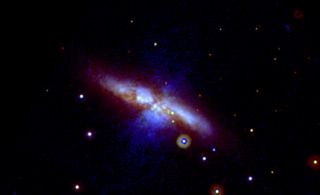Type Ia supernova
A binary star system in which a white dwarf accretes matter from a normal companion star can be a ticking bomb. In this animation, we see such a system from a distance. The white dwarf packs more mass than our sun's into a volume about the size of Earth. Matter streaming from the red star accumulates on the white dwarf until the dwarf explodes. With its partner destroyed, the normal star careens into space. This scenario results in what astronomers refer to as a Type Ia supernova. Because they explode with similar brightness and can be seen across the universe, Type Ia supernovae provide astronomers with information about the distant cosmos.
Supernova animation
Credits
Please give credit for this item to:
Walt Feimer, NASA/Goddard Space Flight Center
-
Animator
- Walt Feimer (HTSI)
Series
This page can be found in the following series:Release date
This page was originally published on Monday, November 23, 2009.
This page was last updated on Wednesday, May 3, 2023 at 1:54 PM EDT.
